
William Magear "Boss" Tweed was an American politician most notable for being the political boss of Tammany Hall, the Democratic Party's political machine that played a major role in the politics of 19th-century New York City and State.

The Congo Free State, also known as the Independent State of the Congo, was a large state and absolute monarchy in Central Africa from 1885 to 1908. It was privately owned by King Leopold II, the constitutional monarch of the Kingdom of Belgium. In legal terms, the two separate nations were in a personal union. The Congo Free State was not a part of, nor did it belong to Belgium. Leopold was able to seize the region by convincing other European states at the Berlin Conference on Africa that he was involved in humanitarian and philanthropic work and would not tax trade. Via the International Association of the Congo, he was able to lay claim to most of the Congo Basin. On 29 May 1885, after the closure of the Berlin Conference, the king announced that he planned to name his possessions "the Congo Free State", an appellation which was not yet used at the Berlin Conference and which officially replaced "International Association of the Congo" on 1 August 1885. The Free State was privately controlled by Leopold from Brussels; he never visited it.
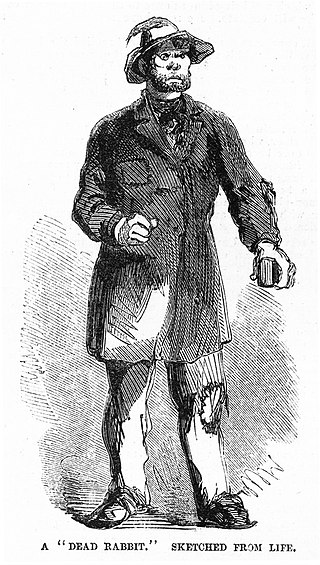
The Dead Rabbits was the name of an Irish American criminal street gang active in Lower Manhattan in the 1830s to 1850s. The Dead Rabbits were so named after a dead rabbit was thrown into the center of the room during a gang meeting, prompting some members to treat this as an omen, withdraw, and form an independent gang. Their battle symbol was a dead rabbit on a pike. They often clashed with Nativist political groups who viewed Irish Catholics as a threatening and criminal subculture. The Dead Rabbits were given the nicknames of "Mulberry Boys" and the "Mulberry Street Boys" by the New York City Police Department because they were known to have operated along Mulberry Street in the Five Points.

Gotham: A History of New York City to 1898 is a non-fiction book by historians Edwin G. Burrows and Mike Wallace. Based on over twenty years of research, it was published in 1998 by Oxford University Press and won the 1999 Pulitzer Prize for History, and detailed the history of the city before the consolidation of the five boroughs in 1898. A follow-up volume, Greater Gotham: A History of New York City from 1898 to 1919, written by Wallace, was published in 2017 and covered New York City history for the following 20 years. Initial plans were to have the second volume's timeline go through World War II, but due to the amount of material, an upcoming third volume should cover the period from 1920 until 1945.
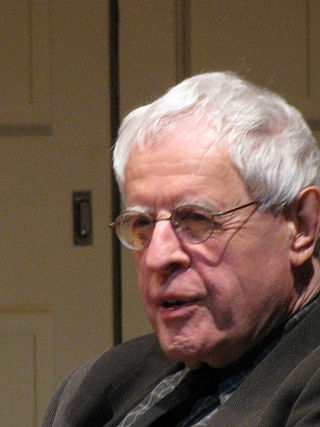
Dušan Simić, known as Charles Simic, was a Serbian American poet and co-poetry editor of the Paris Review. He received the Pulitzer Prize for Poetry in 1990 for The World Doesn't End and was a finalist of the Pulitzer Prize in 1986 for Selected Poems, 1963–1983 and in 1987 for Unending Blues. He was appointed the fifteenth Poet Laureate Consultant in Poetry to the Library of Congress in 2007.
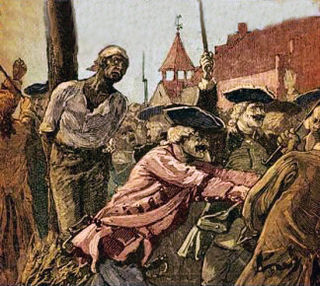
The Conspiracy of 1741, also known as the Slave Insurrection of 1741, was a purported plot by slaves and poor whites in the British colony of New York in 1741 to revolt and level New York City with a series of fires. Historians disagree as to whether such a plot existed and, if there was one, its scale. During the court cases, the prosecution kept changing the grounds of accusation, ending with linking the insurrection to a "Popish" plot by Spaniards and other Catholics.

The First Continental Congress was a meeting of delegates of 12 of the Thirteen Colonies held from September 5 to October 26, 1774 at Carpenters' Hall in Philadelphia at the beginning of the American Revolution. The meeting was organized by the delegates after the British Navy implemented a blockade of Boston Harbor and the Parliament of Great Britain passed the punitive Intolerable Acts in response to the Boston Tea Party.
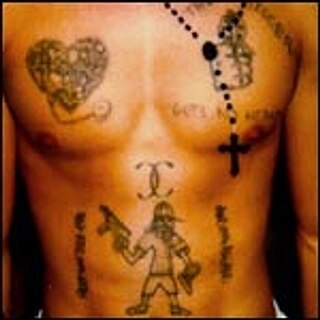
The Crips are an alliance of street gangs that is based in the coastal regions of Southern California. Founded in Los Angeles, California, in 1969, mainly by Raymond Washington and Stanley Williams, the Crips began as an alliance between two autonomous gangs, and developed into a loosely connected network of individual "sets", often engaged in open warfare with one another. Its members have traditionally worn blue clothing since around 1973.

Daniel Horsmanden was a chief justice of the supreme court in the Province of New York and member of the governor's executive council.
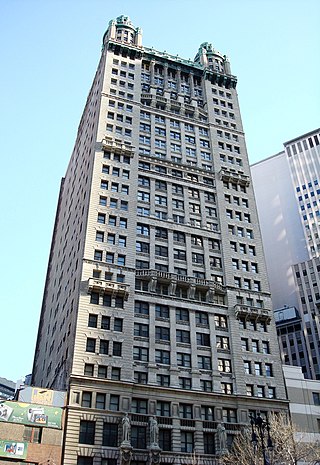
Park Row is a street located in the Financial District, Civic Center, and Chinatown neighborhoods of the New York City borough of Manhattan. The street runs east-west, sometimes called north-south because the western end is nearer to the Financial District. At the north end of Park Row is the confluence of Bowery, East Broadway, St. James Place, Oliver Street, Mott Street, and Worth Street at Chatham Square. At the street's south end, Broadway, Vesey Street, Barclay Street, and Ann Street intersect. The intersection includes a bus turnaround loop designated as Millennium Park.
Frederick Gary Allen was an American conservative writer Allen promoted the notion that international banking and politics control domestic decisions, taking them out of elected officials' hands.
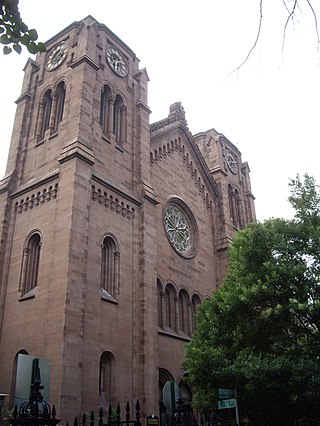
St. George's Episcopal Church is a historic church located at 209 East 16th Street at Rutherford Place, on Stuyvesant Square in Manhattan, New York City. Called "one of the first and most significant examples of Early Romanesque Revival church architecture in America", the church exterior was designed by Charles Otto Blesch and the interior by Leopold Eidlitz. It is one of the two sanctuaries of the Calvary-St. George's Parish.
The Committee of Sixty or Committee of Observation was a committee of inspection formed in the City and County of New York, in 1775, by rebels to enforce the Continental Association, a boycott of British goods enacted by the First Continental Congress. It was the successor to the Committee of Fifty-one, which had originally called for the Congress to be held, and was replaced by the Committee of One Hundred.
The New York Provincial Congress (1775–1777) was a revolutionary provisional government formed by colonists in 1775, during the American Revolution, as a pro-American alternative to the more conservative New York General Assembly, and as a replacement for the Committee of One Hundred. The Fourth Provincial Congress, resolving itself as the Convention of Representatives of the State of New York, adopted the first Constitution of the State of New York on April 20, 1777.

Maiden Lane is an east–west street in the Financial District of the New York City, New York, United States borough of Manhattan. Its eastern end is at South Street, near the South Street Seaport, and its western end is at Broadway near the World Trade Center site, where it becomes Cortlandt Street.
Hell-Cat Maggie was the pseudonym of an American outlaw and early member of the Dead Rabbits. She was a well-known personality in Manhattan's Five Points district and a noted fighter, her teeth reportedly filed into points and her fingers adorned with long, claw-like brass fingernails. She fought alongside the Dead Rabbits and other Five Pointers against rival nativist gangs from the Bowery, most especially the Bowery Boys, during the early 1840s. Although there is little information about her life, she is one of the earliest female outlaws of the "Gangs of New York" era and has been compared to other female outlaws such as Gallus Mag and Battle Annie, the latter leading the female auxiliary of the Gopher Gang during the 1870s.

Gang colors include clothing, accessories, or tattoos of a specific color or colors that represent an affiliation to a specific gang or gang branch.

This timeline of events leading to the American Civil War is a chronologically ordered list of events and issues that historians recognize as origins and causes of the American Civil War. These events are roughly divided into two periods: the first encompasses the gradual build-up over many decades of the numerous social, economic, and political issues that ultimately contributed to the war's outbreak, and the second encompasses the five-month span following the election of Abraham Lincoln as President of the United States in 1860 and culminating in the capture of Fort Sumter in April 1861.

From 1885 to 1908, many atrocities were committed in the Congo Free State under the absolute rule of King Leopold II of Belgium. These atrocities were particularly associated with the labour policies, enforced by colonial administrators, used to collect natural rubber for export. Combined with epidemic disease, famine, and falling birth rates caused by these disruptions, the atrocities contributed to a sharp decline in the Congolese population. The magnitude of the population fall over the period is disputed, with modern estimates ranging from 1.5 million to 13 million.